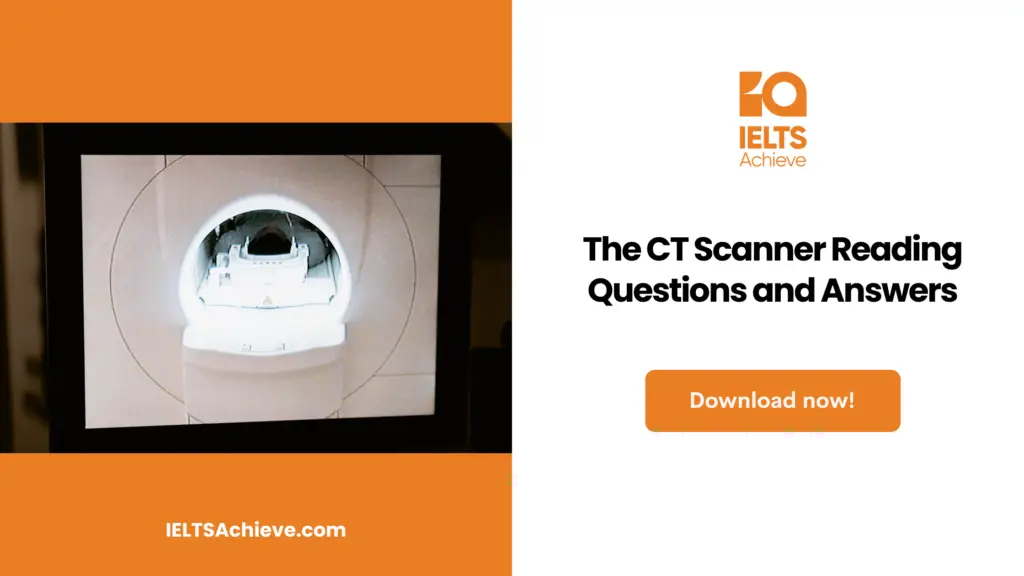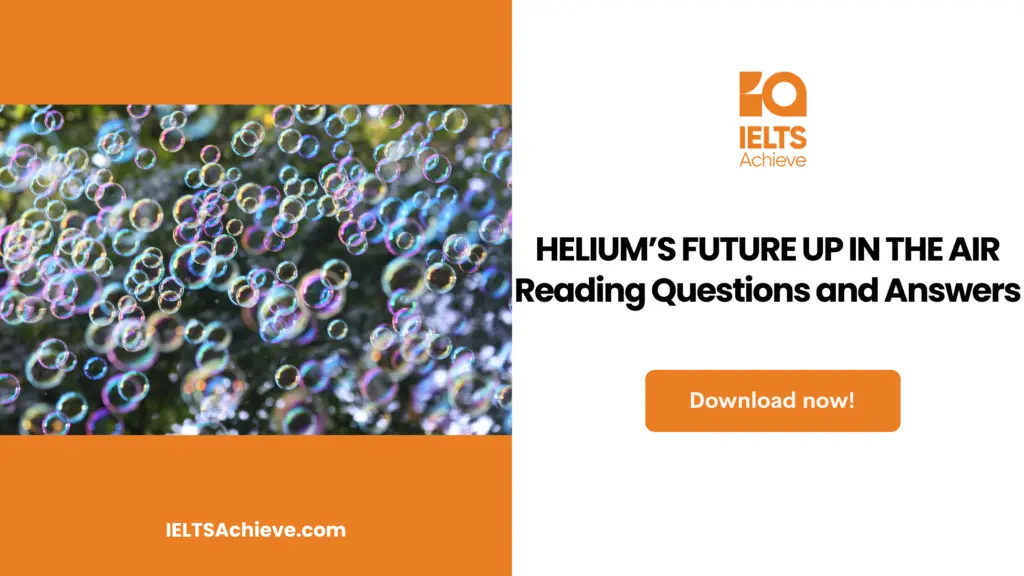The Blog post contains the following IELTS Reading Questions:
- IELTS reading true/false/not given
- IELTS reading matching headings
- IELTS reading table completion
Stay informed and prepared for success – Explore our comprehensive Reading Test Info page to get valuable insights, exam format details, and expert tips for mastering the IELTS Reading section.
IELTS reading passage – The CT Scanner

The CT Scanner
A. The computed tomography scanner or the CT scanner, was initially designed to provide cross-sectional images of the brain. The word tomography is coined from 2 Greek words – tomos, meaning “section,” and graphia, meaning “picture.” Godfrey Hounsfield developed this technique in 1972 and was later recognised and awarded the Nobel Peace Prize for his work in the medical field. Within 4 years of this development, CT scans, also called CAT scans (computed axial tomography), were reconstructed, allowing them to scan the entire body for evidence of tumours, injuries, and other abnormalities. Unlike an X-ray, which takes a single picture, a CT scanner sends multiple beams into an area and takes photographs from many different angles.
B. While the original CT scans took Hounsfield several hours to reconstruct into a useful image, today’s CT scanners can construct an in-depth image in a split second. Creating a scanner that could produce images at a faster rate was important in the development of tomography, as it reduced the degree of distortion in an image due to movement of patients while breathing or moving. The new scanners provided images with better resolution, and also more comfort for the patients.
C. During a CT scan, a patient must lie on a special table without moving while the radiology technician identifies the specific area that needs to be photographed. The table slides into a round tunnel (gantry), where it can be rotated or moved forward and backwards to obtain the necessary view. Inside the doughnut-shaped machine, a number of X-ray images are taken, each creating a small slice of the image that doctors require. When passing through dense tissues like bones, the X-ray beams become weak and develop a white colour in the CT images. Tissues seen in the brains are less dense and the images come out as grey. Images that become black denote organs such as lungs and other parts that fill with air.
D. The CT scanner consists of several computer systems, with a host computer, which controls the entire process. One of the computers converts the raw data from scanning into an image, while another computer allows the technician to control the rotation of the gantry. After the data is processed, it is shown on a screen for radiologists and physicians to analyse. The data can be saved and printed to keep in the doctor’s records and to share and discuss with patients and their family members.
E. Physicians order CT scans for many reasons, including searching for tumours and assessing them. They can also check for cysts, kidney stones, and bone injuries. Without CT scanners, surgeons would have to perform many needless and costly operations. Brain, chest, and abdominal CT scans are done commonly, though physicians also rely on the CT scanner to guide their needles while draining an abscess or performing a biopsy. Most emergency or shock-treatment centres contain a CT scanner for assessing trauma victims. CT scans can find out internal bleeding both in the brain and throughout the body.
F. In most cases, a patient should be given a contrast material before undergoing a CT scan. During “dynamic CT scanning,” iodine dye is either injected into the blood or added to a drink that the patient must consume approximately 45 minutes before entering the scanner. The liquid X-ray dye makes it easier for the scanner to see the organs and blood vessels when the pictures are produced. This contrast material is used mostly for chest or pelvic scans, whereas oral-contrast material is used for abdominal scans. In some cases, physicians need the pictures to be taken both before and after the contrast material enters the patient’s body. Patients who take the contrast material in their arm often report a warm sensation, and in rare cases, an allergic reaction occurs. Patients can suffer water loss when contrast material is injected. So it is avoided when scanning patients who suffer from kidney failure.
G. The hazards of radiation exposure caused by X-ray beams are generally considered minute compared to the benefits that a CT scan can provide. For example in cases of finding tumours and internal bleeding, CT scans provide information that can save a person’s life. Full-body scanning, which is saved for serious conditions such as coronary artery disease, remains a questionable procedure as prolonged exposure to these radiations is linked to cancer. CT scans are not done on pregnant women as the X rays can be harmful to the foetus. When pregnant women require an evaluation, most physicians choose to use other procedures like ultrasound scanning or MRI.
Unlock your full potential in the IELTS Reading section – Visit our IELTS Reading Practice Question Answer page now!
Recommended Questions:
Renewable Energy IELTS Reading Question with Answer
The CT Scanner IELTS reading questions
Questions 1-4
Do the following statements agree with the information given in the reading passage?
Write
- TRUE if the statement agrees with the information
- FALSE if the statement contradicts the information
- NOT GIVEN if there is no information on this in the passage
1. Godfrey Hounsfield won the Nobel Prize for inventing the computed tomography scanner technique.
2. The new CT scanner takes many minutes to develop images of the body parts.
3. The images of bones in CT images come in white colour.
4. CT scans can be done on pregnant women
Enhance your skills in identifying information as True, False, or Not Given. Click here to discover expert strategies and techniques for mastering this question type in the IELTS Reading section.
Questions 5 – 11
The reading passage has three paragraphs, A-G.
Choose the correct heading for each paragraph from the list of headings below.
Write the correct number, i-viii, as your answer to each question.
List of Headings:
i) Brain and Chest Scan
ii) Role of Computers
iii) Invention CT Scan
iv) High Cost of CT Scans
v) The Risks of using the CT Scan
vi) The Emergency Room Care
vii) Faster and More Comfortable
viii) How Doctors Use CT Scan
ix) How The Patient is Photographed
x) Enhancing Scan Images with Dyes
5. Paragraph A
6. Paragraph B
7. Paragraph C
8. Paragraph D
9. Paragraph E
10. Paragraph F
11. Paragraph G
Ready to conquer Matching Headings questions? Click here to learn essential tips and techniques for matching headings accurately to paragraphs or sections in the IELTS Reading section.
Questions 12-15
Complete the table below
Write NO MORE THAN THREE WORDS from the passage for each answer.
| Material | Function |
| 12 ________ | Rotate or move the table forward and backwards to obtain the necessary view. |
| 13 ________ | Makes it easier for the scanner to see the organs and blood vessels when the pictures are produced |
| 14 ________ | Used for abdominal scans. |
| Computer | Converts the 15 ________ from scanning into an image |
Boost your performance in Summary, Notes, Table, and Flowchart Completion tasks. Click here to explore our detailed guide and learn how to effectively complete summaries, notes, tables, and flowcharts in the IELTS Reading section.
Unlock your full potential in the IELTS Reading section – Visit our IELTS Reading Practice Question Answer page now!
Recommended Questions:
Renewable Energy IELTS Reading Question with Answer
The CT Scanner IELTS reading answers
1. True
2. False
3. True
4. False
5. Paragraph A = iii
6. Paragraph B = vii
7. Paragraph C = viii
8. Paragraph D = ii
9. Paragraph E = i
10. Paragraph F = x
11. Paragraph G = v
12. .Gantr
13. iodine dye
14. oral-contrast material
15 . raw data

We hope you found this post useful in helping you to study for the IELTS Test. If you have any questions please let us know in the comments below or on the Facebook page.
The best way to keep up to date with posts like this is to like us on Facebook, then follow us on Instagram and Pinterest. If you need help preparing for the IELTS Test, join the IELTS Achieve Academy and see how we can assist you to achieve your desired band score. We offer an essay correction service, mock exams and online courses.

